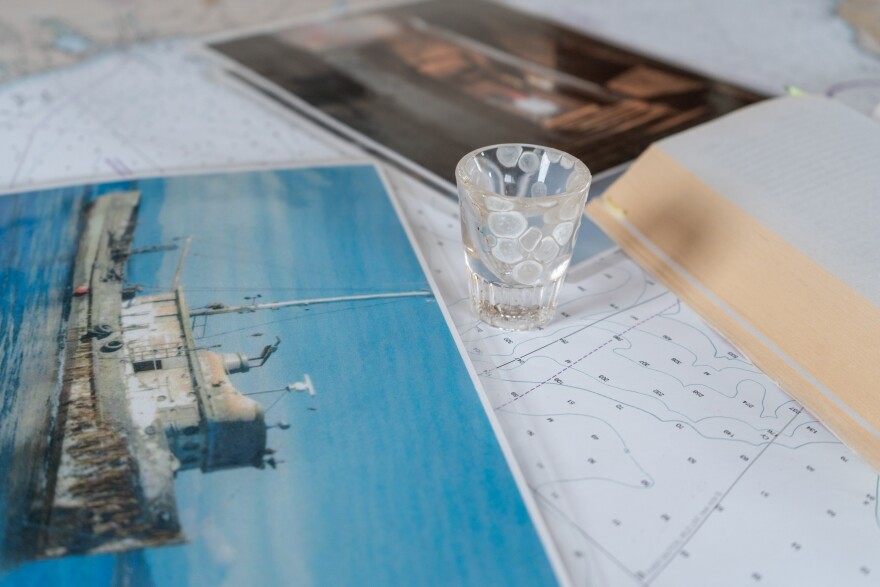A brisk wind, overcast skies and the threat of heavy rain keep the Western Flyer safely inside Moss Landing Harbor on a November day. For the eight students from Cal State Monterey Bay’s Science Student Success Program, it means today’s journey of discovery will be dockside instead of the planned cruise on the bay.
But they’re here on board the boat that carried author John Steinbeck and his friend Ed Ricketts, a biologist, to the Sea of Cortez thanks to the Western Flyer Foundation. It deploys the Western Flyer to blend science and art, stir curiosity, and introduce students to ocean science.
The Foundation’s education director, Rebecca Mostow, stands on the back deck and greets the students. Today’s lesson is a mixture of marine science, literature, history and philosophy with an occasional interruption from nature.
“Something fun is happening behind me,” Mostow says, as she notices a distraction in the water.
“Just a little bit of light porpoising,” responds another instructor.

The students quickly turn their heads from the boat to the harbor to catch a sea lion’s head before it disappears again under the water
“Let's not talk about John Steinbeck when the sea lions are doing something fun,” says Mostow.
White with green trim, the 77-foot Western Flyer was designed as a typical fishing boat. But now, it’s a changing and immersive classroom. Mostow says being flexible as a teacher gives her students an opportunity to follow their curiosity, instead of a lesson plan. There is plenty for the students to be curious about.
“They can live 20 minutes from the bay but never get a chance to, like, put their feet in the water,” says Mostow. “We think everyone deserves a chance to hang out in the bay and think about how amazing it is.”
The first scientific observation of the day involves a plate with black and white markings on it called a Secchi disk. It is lowered into the murky water until it can’t be seen.

The students huddle in pairs around the boat’s railing and lower their Secchi disks into the water.
“It’s one, right there,” says a student in one of the pairs.
“That is one meter,” says the other. “I can't even see it.”
By measuring the distance from the submerged disk to the surface, the young scientists can determine the water’s clarity, or turbidity. The murky water of Moss Landing Harbor is clouded with plankton and sediment. The average measurement is one meter.
Sierra Garcia, another instructor from the Western Flyer Foundation, points to one of the students.
“What this really means is that if Karla is in the harbor, and is a sea lion, and I am standing right here looking directly towards Karla,” says Garcia, “I'm not going to see anything in this water because of the turbidity.”
“It's so freaky,” one of the students says, prompting laughter.

Next, the students measure the salinity and temperature of the water. They also drag nets through the water to capture plankton, which they observe through a microscope in the lab below deck.
Later, sitting inside the cabin, Mostow reads to the students from The Log From The Sea of Cortez. It chronicles Steinbeck and Ricketts’ journey to the Gulf of California, which Steinbeck renamed the Sea of Cortez.

The stated purpose of their trip was to gather marine specimens. But that wasn’t the only reason they went.
“We were curious," Mostow reads from the book. "Our curiosity was not limited, but was as wide and horizonless as that of Darwin or Agassiz or Linnaeus or Pliny.”
While on board, the students also learn the history of the Western Flyer. It was built to fish for sardines in Monterey Bay and, except for the 4,000 mile trip to the Sea of Cortez, that’s exactly what it did. Then the sardines ran out. After sardines, the boat was used in other commercial fisheries. It sank twice from disrepair. Finally, the Foundation was created and money raised to restore the boat. It took nearly a decade of work in Washington state, but last year the Western Flyer returned—seaworthy once more, and with updated equipment—to Monterey Bay.

Elizabeth Schaefer is one of the Cal State Monterey Bay students who, like Steinbeck and Ricketts before them, boarded the Western Flyer to indulge their curiosity and experience the joy of discovery.
“This is incredible. I can't believe I'm here,” Schaefer says. “This is such a gold nugget.”
Editor's note: this story has been updated to correct the spelling of Agassiz.



